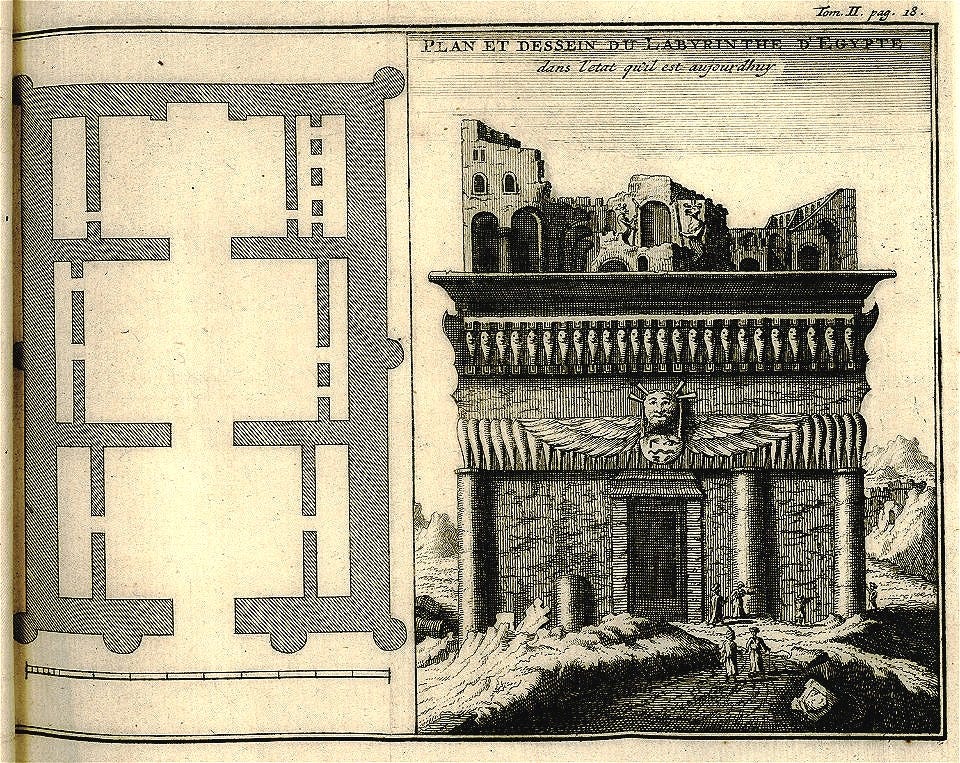For centuries, scholars and adventurers sought the legendary Egyptian Labyrinth, a monumental complex described by Herodotus, Strabo, and Pliny as surpassing even the Great Pyramids in scale and complexity. Though it was long thought to be lost, early explorers left behind tantalizing clues about its possible survival. The Mataha Expedition of 2008 built upon their legacy, using modern science to search for what remains buried beneath the sands of Hawara.
The Pioneers Who Searched for the Labyrinth
✤ Paul Lucas (1664-1737 CE)
An antiquary for King Louis XIV of France, Lucas was one of the first to document the ruins of the labyrinth’s possible location. He claimed to have met an Arab who, in his youth, had explored a subterranean network beneath the sands—confirming local legends of hidden chambers.
✤ Richard Pococke (1704-1765 CE)
An English traveler and scholar, Pococke visited Egypt in the 18th century and described seeing mounds of ruins at the supposed labyrinth site near Hawara. He noted that the labyrinth was already long buried but that the surrounding area still bore traces of its former grandeur.
Who Were Paul Lucas and Richard Pococke?
✤ Paul Lucas (1664-1737 CE) – French Explorer & Antiquary for Louis XIV
Paul Lucas was a French merchant, traveler, and antiquarian, serving as a personal agent for King Louis XIV. He was sent on multiple missions to the Middle East and North Africa to acquire rare manuscripts, antiquities, and intelligence on ancient sites. His published travelogues—particularly Voyage du Sieur Paul Lucas, fait par ordre du Roi dans la Turquie, l’Asie, la Syrie, la Palestine, la Haute et la Basse-Égypte (1704)—contain some of the earliest European accounts of the Egyptian Labyrinth.
Lucas reported meeting an elderly Arab who, in his youth, had explored a vast underground complex beneath the sands of Hawara. His description aligned with ancient accounts of hidden chambers and passageways, reinforcing local legends that remnants of the labyrinth still existed. Though many of his claims were met with skepticism in his time, his writings influenced later explorers searching for the lost structure.
✤ Richard Pococke (1704-1765 CE) – British Explorer & Early Egyptologist
Richard Pococke was an English clergyman, geographer, and pioneering Egyptologist, best known for his extensive travels in the Middle East and North Africa. His book, A Description of the East and Some Other Countries (1743-1745), was one of the first systematic Western surveys of Egyptian antiquities, including the pyramids, temples, and the ruins of Hawara.
During his expedition to Hawara in the 1730s, Pococke documented large mounds of rubble, which he believed to be the remains of the legendary labyrinth. Though he was unable to excavate, his detailed illustrations and descriptions provided valuable information for later explorers like Napoleon’s scholars, Karl Richard Lepsius, and Flinders Petrie. His work laid the foundation for modern Egyptology, and his observations continue to be referenced in archaeological studies.
For those interested in the full official results and whitepapers of the Mataha Expedition, follow this link: labyrinthofegypt_com__printversion.pdf > [https://drive.google.com/file/d/1YqntaYOhvSWA7fd3jFYToPqx34odntjB/view]






